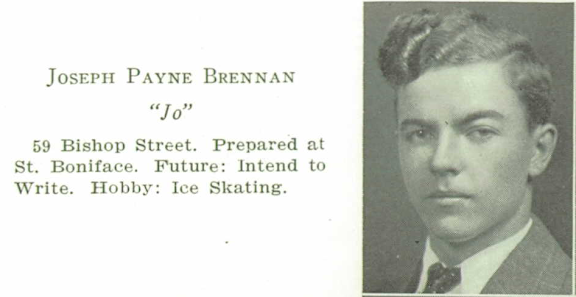Brennan & Lovecraft
Joseph Payne Brennan (1918-1990) was old enough to have corresponded with and even to have met H.P. Lovecraft (1890-1937). Like Lovecraft's eventual literary executor, Robert H. Barlow (1918-1951), he could have, as a teenager, entered into Lovecraft's circle. But he didn't. Brennan was also old enough and probably good enough and talented enough to have been published in Weird Tales in the 1940s, possibly even in the 1930s. But he wasn't. Instead, he went his own way and seems to have worked almost in isolation for years. One thing to keep in mind here is that Brennan went to work before his twentieth birthday in order to support his family. He also lost three years of his writing life while serving in the U.S. Army in Europe during and after World War II. We can wonder about what might have been, but that doesn't do much good. Instead, we have what we have from Joseph Payne Brennan, which is no small thing at all.
Brennan was quiet and reserved. In photographs, the look on his face is the same, no matter when the photograph might have been taken: serious, unsmiling, possibly sad, maybe a little bit grim. Many of his poems are of sadness and loss. Like Lovecraft, he was filled with nostalgia, for an ideal time in the past, especially for a time before his family went into decline. He said:
I'm attracted to the Victorian period, I think, because it had at least the illusion of stability and permanence. [. . .] My grandmother here--my father's parents flourished in that time. They had a large, happy, successful family. They were relatively wealthy and successful and since I personally have known mostly poverty, I suppose I look back and wish I could have been in that prior generation. You know, they had a big house and a maid, all the amenities. I am not sure how my grandfather achieved all this but he did. And also it seems to me that since that generation, more deprivation and trouble and unhappiness has come to succeeding generations. (1)
I have written before on the idea that weird fiction is about the past and looks to the past, with loss and longing and nostalgia. Brennan's sentiments are as good as any in bearing out that idea.
Brennan was a bibliographer of H.P. Lovecraft, an essayist and poet on him, too. Here is a list of his Lovecraft-related works:
- A Select Bibliography of H. P. Lovecraft (1952)
- H. P. Lovecraft: A Bibliography (1952)
- H. P. Lovecraft: An Evaluation (1955)
- "H. P. L.: An Informal Commentary" in Howard Phillips Lovecraft Memorial Symposium (1958)
- "Lovecraft's 'Brick Row'" in Macabre (Summer 1959)
- "Lines to H. P. Lovecraft" (poem) in Macabre (Summer, 1959), reprinted in The Shuttered Room and Other Pieces (Arkham House, 1959)
- "Time and H.P.L." in Macabre (Summer 1960)
- "Three Footnotes on H.P. Lovecraft" in Macabre (Summer 1961)
- "A Haunter of the Night" in HPL (1972)
- "Lovecraft on the Subway" in Macabre (1973)
- "Lovecraft and the O'Brien Annuals" in Macabre (1976)
This compilation is from the Internet Speculative Fiction Database (ISFDb) and includes only those works that refer to Lovecraft by name in their titles. There may be others.
Like Lovecraft, Brennan was a writer of stories, poems, and non-fiction. He was involved in amateur press and small press and was a prolific correspondent, including with August Derleth (1909-1971). Brennan had at least one story, "The Feaster from Afar," in the Cthulhu Mythos. It appeared in the collection The Disciples of Cthulhu, published by DAW Books in 1976. Like Lovecraft, he was a New Englander and had a strong sense of place. Brennan said of himself, "I'm more apt to be intrigued by a landscape than by a personality." (2) The same deemphasis on personality or characterization is also in Lovecraft.
Brennan wrote about nature in a more sympathetic way than did Lovecraft, I think. Although both men were urbanites, Brennan spent his childhood summers on his grandparents' farm in East Hartland, Connecticut. Although he wrote of the old New England devil-in-the-woods, Brennan doesn't seem to have been alienated from nature, nor to have been squeamish about the forces and ways of nature. On the other hand, threats supposedly represented by nature have become clichés in our popular culture. It seems likely to me that they were no less clichés in Lovecraft's time. And so Lovecraft and others personified--or demonized--nature, such as with the whip-poor-will, a bird, a mere bird of the gloaming and of the tangled woods. It's worth noting that Brennan had at least two works referring to Nietzsche, a poem by that title in his 1949 collection Heart of Earth, and "Zarathustra at the Gate," from the same collection. A look at Lovecraft and Nietzsche might be worth the time spent. Or has someone already done the looking?
One last thing in regards to Brennan and Lovecraft: like Lovecraft, Brennan has his papers at the John Hay Library at Brown University.
Notes
(1) From "Etchings & Odysseys Interview: Joseph Payne Brennan" in Etchings & Odysseys #7 (1985), pages 58-59.
(2) From the same source, page 59.
Original text copyright 2022 Terence E. Hanley





